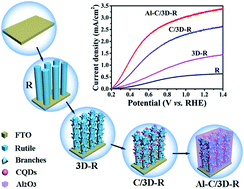Alumina anchored CQDs/TiO2 nanorods by atomic layer deposition for efficient photoelectrochemical water splitting under solar light†
Abstract
In this study, a new carbon quantum dot (CQD) sensitized TiO2 nanorod (NR) electrode with a branch structure was fabricated for photoelectrochemical (PEC) water splitting by simple hydrothermal and impregnation methods. To enhance the adhesion between CQDs and TiO2 NRs and to accelerate the separation of electrons and holes by improving the interface properties, a thin Al2O3 passivation layer was introduced using an atomic layer deposition (ALD) technique to coat the outer surface of CQDs/TiO2 NRs. With the Al2O3 deposition thickness of 5 nm, a high photocurrent density of 3.20 mA cm−2 at 1.23 V vs. the reversible hydrogen electrode (RHE) and an incident-photon-to-current efficiency (IPCE) value of 77.41% at the wavelength of 385 nm were achieved under air mass 1.5 global (AM 1.5 G) illumination, which were nearly 5.35 times and 6.94 times higher than those of pure TiO2 NRs, respectively. In addition, the IPCE value increased from 3.19% to 5.16% at 440 nm, owing to the sensitization effect of CQDs which has obvious visible light absorption. More importantly, the photocurrent had nearly no decay during the PEC testing after coating the thin Al2O3 layer, greatly solving the falling off and instability problems of CQDs on the TiO2 NR surface, which makes it possible to be used in practical PEC water splitting, solar cells and other photocatalysis devices.



 Please wait while we load your content...
Please wait while we load your content...